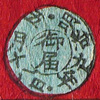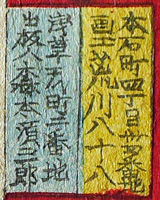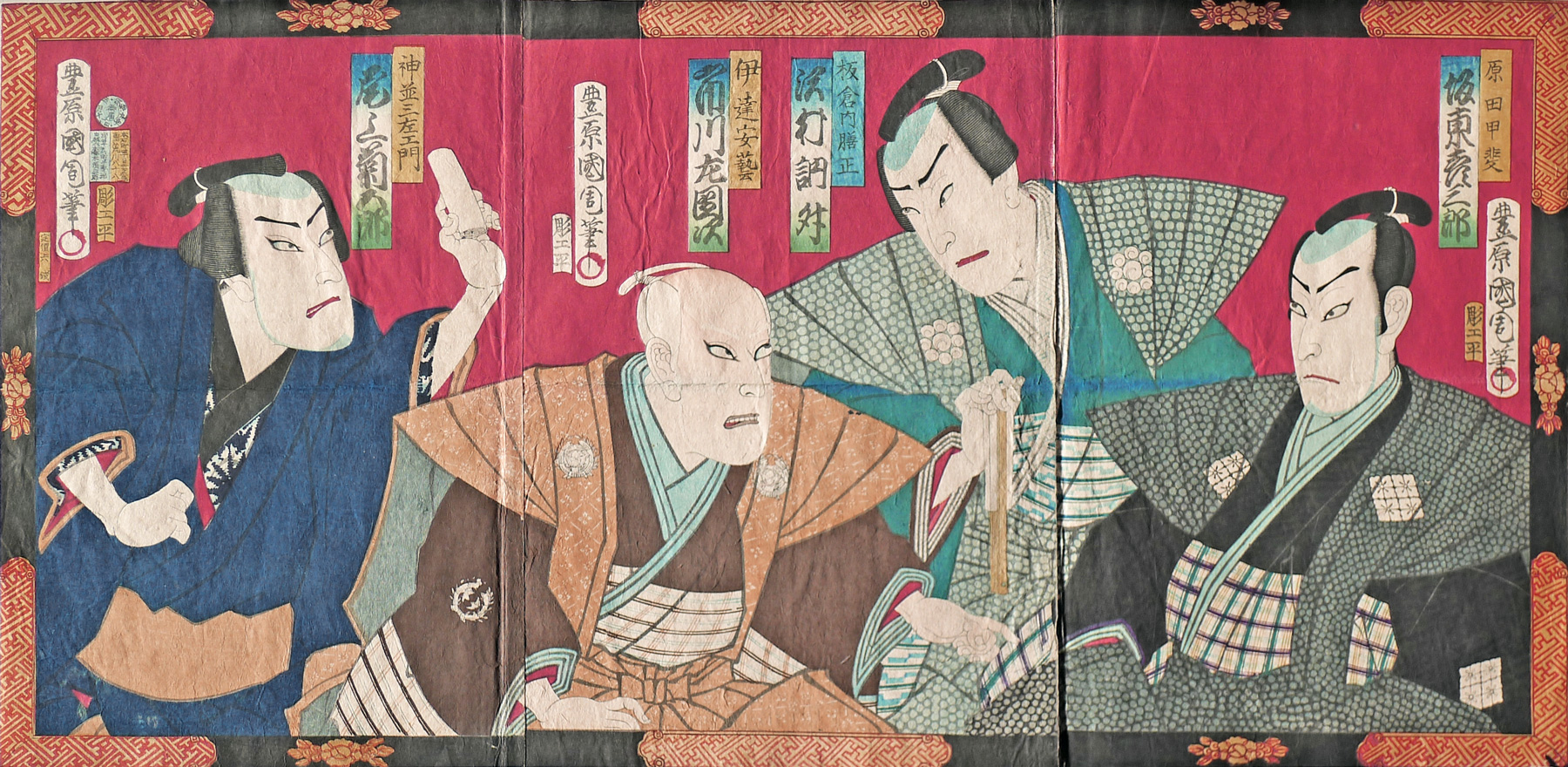About This Print
Issued as a promotion for the play Hototogisu Date no kikigaki staged at Tokyo's Shintomi theater in June 1876, this print features the following actors (from right to left):Bandō Hikosaburō V 坂東彦三郎 as Harada Kai 原田甲斐
Sawamura Tosshō II 沢村訥升 as Itakura Naizen 板倉内膳正
Ichikawa Sadanji I 市川左団次 as Date Aki 伊達安芸
Onoe Kikugorō V 尾上菊五郎 as Kaminami Sanzaemon 神並三左衛門
For background on the actors see their respective entries in the article The Kabuki Actor on this site.
The Play "Hototogisu Date no kikigaki"
Source: Kabuki21 website http://www.kabuki21.com/jitsuroku_sendai_hagi.php
Hototogisu Date no kikigaki, written in 1876 by By Kawatake Mokuami 河竹默阿彌 (1816-1893), tells the story of Harada Kai, a Date vassal, and his confederates who are plotting to usurp the power and position of the young leader of the clan, Kamechiyo. They have attempted to poison him, but their efforts have so far been thwarted by those loyal to the boy, particularly his menoto (wet nurse), Asaoka. She is keeping a close watch over him in the inner, women's quarters of the Date mansion. A senior retainer in the Date household, Katakura Kojūrō, warns Asaoka that the day of a retaliatory strike against Harada and the other conspirators is near. Asaoka is relieved to hear it, but she continues to keep a close watch over her charge.
Katakura has been watching all this from a neighboring room. He enters and commends both Asaoka and her son for their loyalty towards Kamechiyo. He then leaves, taking Chiyomatsu with him. Left alone, Asaoka gives way to her feelings and expresses her grief at the departure of her beloved son. At that moment, however, the alarm is raised following the death by poisoning of one of those required to taste Kamechiyo's food. Asaoka takes a grip on herself and resumes her watch over the boy.
In 1893, the play was renamed Jitsuroku sendai hagi 實錄先代萩 and was first performed under this new name in May of that year at Tokyo's Fukano theater.
Print Details
| IHL Catalog | #1219 |
| Title (Description) | Bandō Hikōsaburō V, Sawamura Tosshō II, Ichikawa Sadanji andOnoe Kikurguro V in Hototogisu Date no kikigaki 早苗鳥伊達聞書 |
| Artist | Toyohara Kunichika (1835–1900) |
| Signature |  |
| Seal | toshidama seal below signature |
| Publication Date |  御届明治九年五月十八日 1876, fifth month, eighteenth day |
| Publisher |  seal of Morimoto Junzaburō 森本 順三郎 [Marks 25-116, publisher ref. 349] |
| Carver |  |
| Impression | excellent |
| Colors | excellent |
| Condition | fair - trimmed to image; three sheets joined together and backed; horizontal fold across center of print; wrinkling |
| Genre | ukiyo-e; yakusha-e; 芝居絵 shibai-e (drama print) |
| Miscellaneous | |
| Format | vertical oban triptych |
| H x W Paper | 13 3/4 x 28 1/4 in. (34.9 x 71.8 cm) |
| Literature | |
| Collections This Print | The Tsubouchi Memorial Theatre Museum of Waseda University 100-7227, 7228, 7229 |


